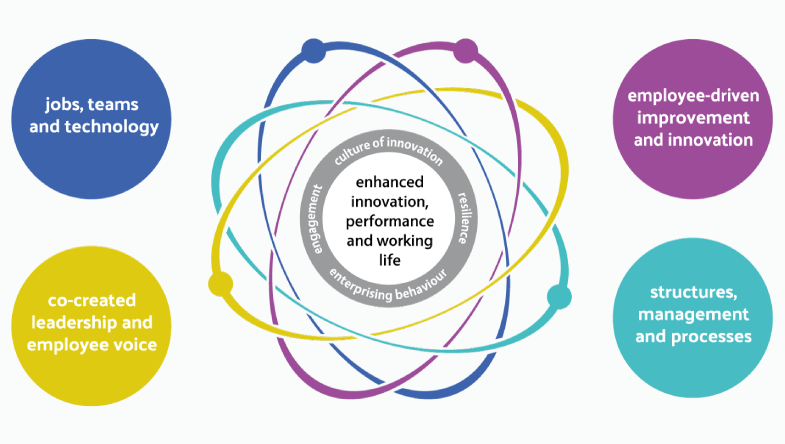What is workplace innovation?
Organisations of every size and sector report higher performance, better places to work and an enhanced culture of innovation.
Workplace Innovation, what’s it all about?
Companies face unprecedented challenges in an economy dominated by globalisation, rapid technological advances, demographic change and fast-shifting consumer demands. The ability to reinvent products, services and processes continually is becoming essential for survival and success.
Tackling these challenges can’t be done by senior teams alone: they need to harness the creativity, insights and engagement of the entire workforce. Leaders need to empower others to take the initiative, coaching and supporting them towards successful outcomes. They must become the champions of employee empowerment, participation and voice.
The Fifth Element
The task set by EU policymakers following the inauguration of EUWIN in 2013 was to create a coherent and accessible roadmap for the adoption of workplace innovation by companies and public sector organisations. ‘The Fifth Element’ was developed by Workplace Innovation Limited as co-leader of EUWIN to guide practitioners through workplace innovation and provide guidance on its implementation.
Expanding the original Hi-Res framework, The Fifth Element is grounded in an extensive analysis of articles and case studies. The analysis identified four bundles (or ‘Elements’) of working practices with a strong association between high performance and high quality of working life (see table below). Alignment between these Elements creates a synergy in the form of the ‘Fifth Element’, a system of mutually interdependent parts which leads to a sustainable culture of innovation and empowerment embedded throughout the organisation.
| Element | Indicative Practices | Associated Outcomes |
| Jobs, Teams & Technology | Individual discretion Job variety Constructive challenges Self-managed teams Collaboration within the team Reflective team practices People-centred technologies |
Improved workflow Enhanced quality Better productivity Cost reduction Engagement and retention Improved workforce health |
| Employee-Driven Innovation & Improvement | Productive reflection in teams Cross-team improvement groups Permission to experiment Company-wide innovation events |
Enhanced capacity for innovation & improvement Enterprising behaviour Enhanced quality & performance Learning & development Engagement & retention Intrinsic job satisfaction |
| Organisational Structures, Management and Procedures | Reduced hierarchies and silos Strengths-based career structure Coaching style line management Appraisals focused on learning and innovation Simplified procedures |
Improved workflow Cost reduction Better productivity Engagement & retention Improved workforce health |
| Co-Created Leadership & Employee Voice | Openness and transparency Emotionally intelligent behaviours Visible leadership Delegated decision-making Representative participation |
Strategic alignment Better decision-making Engagement and retention |
| The Fifth Element | Creating synergy through alignment between the four elements – a system of mutually reinforcing practices
A culture of empowerment and innovation |
Win-win outcomes for the organisation and its employees |
The Essential Fifth Element
The Essential Fifth Element is our practical approach to workplace innovation and organisational change, grounded in extensive evidence and experience.
It has helped growing numbers of multinational companies, SMEs, third sector bodies and the public sector achieve tangible performance gains as well as improved working lives for employees.








